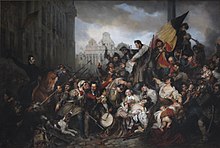conflict which led to the secession of the southern provinces from the United Kingdom of the Netherlands and the establishment of an independent Kingdom of Belgium From Wikipedia, the free encyclopedia
The Belgian Revolution was the secession of the Southern provinces from the United Kingdom of the Netherlands. It made an independent Kingdom of Belgium.
| The Belgian Revolution | |||||||
|---|---|---|---|---|---|---|---|
 Episode of the Belgian Revolution of 1830, Gustaf Wappers (1834), (Museum of Modern Art, Brussels) | |||||||
| |||||||
| Belligerents | |||||||
|
|
| ||||||
| Commanders and leaders | |||||||
| William I of the Netherlands |
Erasme Louis Surlet de Chokier Charles Latour Rogier Étienne Maurice Gérard | ||||||
The people of the southern part of the United Kingdom of the Netherlands were mostly Roman Catholic and the elite was French-speaking. They did not like the Protestant King William I's rule, or that he had revoked certain special privileges granted to the Catholic Church.
On August 25, 1830 riots started in Brussels and shops were looted. There was an opera playing about liberty of the fatherland, and the theater-goers joined the rioters. The King sent troops to stop the riots.
A battle took place in Brussels. The French came to support the breakaway province of Belgium. Belgium won the battle and became an independent country. Leopold I was made "King of the Belgians" in 1831. It took until 1839 for the Dutch to say Belgium was independent. They signed the Treaty of London.
Seamless Wikipedia browsing. On steroids.
Every time you click a link to Wikipedia, Wiktionary or Wikiquote in your browser's search results, it will show the modern Wikiwand interface.
Wikiwand extension is a five stars, simple, with minimum permission required to keep your browsing private, safe and transparent.